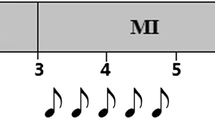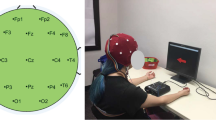Abstract
This article reports on a study to identify electroencephalography (EEG) signals with potential to provide new BCI channels through mental motor imagery (MMI). Leg motion was assessed to see if left and right leg MMI could be discriminated in the EEG. The study also explored simultaneous observation of leg movement as a means to enhance MMI evoked EEG signals. The results demonstrate that MMI of the left and right leg produce a contralateral preponderance of EEG alpha band desynchronization, which can be spatially discriminated. This suggests that lower extremity MMI could provide signals for additional BCI channels. The study also shows that movement imitation enhances alpha band desynchronization during MMI, and might provide a useful aid in the identification and training of BCI signals.






Similar content being viewed by others
References
Allison T, McCarthy G, Luby M, Puce A, Spencer DD (1996) Localization of functional regions of human mesial cortex by somatosensory evoked potential recording and by cortical stimulation. Electroenceph Clin Neurophysiol 100:126–140
Barlow JS (1993) The electroencephalogram: its patterns and origins. MIT Press, Cambridge, MA
Bear M, Bear MF, Connors BW, Paradiso MA (2005) Neuroscience: exploring the brain, 2nd edn. Williams and Wilkins, Baltimore, MD
Boord P, Barriskill A, Craig A, Nguyen H (2004) Brain computer interface-FES integration: towards a hands-free neuroprosthesis command system. Neuromodulation 7:267–276
Decety J, Perani D, Jeannerod M, Bettinardi V, Tadary B, Woods R, Mazziotta JC, Fazio F (2002) Mapping motor representations with positron emission tomography. Nature 371:600–602
Delorme A, Makeig S (2004) EEGLAB: an open source toolbox for analysis of single-trial EEG dynamics including independent component analysis. J Neurosci Methods 134:9–21
Fadiga L, Fogassi L, Pavesi G, Rizzolatti G (1995) Motor facilitation during action observation: a magnetic stimulation study. J Neurophysiol 73:2608–2611
Grafton ST, Fadiga L, Arbib MA, Rizzolatti G (1997) Premotor cortex activation during observation and naming of familiar tools. Neuroimage 6:231–236
Hari R, Salmelin R, Makela JP, Salenius S, Helle M (1997) Magnetoencephalographic cortical rhythms. Int J Psychophysiol 26:51–62
Hari R, Forss N, Avikainen S, Kirveskari E, Salenius S, Rizzolatti G (1998) Activation of human primary motor cortex during action observation: a neuromagnetic study. Proc Natl Acad Sci USA 95:15061–15065
Hjorth B (1975) An on-line transformation of EEG scalp potentials into orthogonal source derivations. Electroencephal Clin Neurophysiol 39:526–530
Hwang HJ, Kwon K, Im CH (2009) Neurofeedback-based motor imagery training for brain–computer interface (BCI). J Neuroscience Methods 179:150–156
Iacoboni M, Woods RP, Brass M, Bekkering H, Mazziotta JC, Rizzolatti G (1999) Cortical mechanisms of human imitation. Science 286:2526–2528
Jung TP, Makeig S, Humphries C, Lee TW, McKeown MJ, Iragui V, Sejnowski TJ (2000) Removing electroencephalographic artifacts by blind source separation. Psychophysiol 37:163–178
Klem GH, Luders HO, Jasper HH, Elger C (1999) The ten–twenty electrode system of the International Federation. Electroenceph Clin Neurophysiol S52:3–6
Krausz G, Scherer R, Korisek G, Pfurtscheller G (2003) Critical decision-speed and information transfer in the “Graz Brain–Computer Interface”. Appl Psychophysiol Biofeed 28:233–240
Lauer RT, Peckham PH, Kilgore KL (1999) EEG-based control of a hand grasp neuroprosthesis. Neuroreport 10:1767–1771
Müller-Putz GR, Scherer R, Pfurtscheller G, Rupp R (2005) EEG-based neuroprosthesis control: a step towards clinical practice. Neurosci Lett 382:169–174
Neuper C, Pfurtscheller G (1996) Post-movement synchronization of beta rhythms in the EEG over the cortical foot area in man. Neurosci Lett 216:17–20
Neuper C, Pfurtscheller G (1999) Motor imagery and ERD. In G. Pfurtscheller & F. H. Lopes da Silva (Eds.), Event-Related Desynchronization, Handbook of Electroenceph. and Clin. Neurophysiol., rev. ed., vol. 6: 303-325. Amsterdam, The Netherlands: Elsevier
Neuper C, Scherer R, Wriessnegger S, Pfurtscheller G (2009) Motor imagery and action observation: modulation of sensorimotor brain rhythms during mental control of a brain–computer interface. Clin Neurophysiol 120:239–247
Nishitani N, Hari R (2000) Temporal dynamics of cortical representation for action. Proc Natl Acad Sci USA 97:913–918
Obermaier B, Neuper C, Guger C, Pfurtscheller G (2001) Information transfer rate in a five-classes brain–computer interface. IEEE Trans Neural Sys Rehab Eng 9:283–288
Obermaier B, Muller GR, Pfurtscheller G (2003) “Virtual keyboard” controlled by spontaneous EEG activity. IEEE Trans Neural Sys Rehab Eng 11:422–426
Pfurtscheller G, Lopes da Silva FH (2004) Event-related desynchronization. Elsevier, Amsterdam
Pfurtscheller G, Neuper C, Andrew C, Edlinger G (1997) Foot and hand area mu rhythms. Int J Psychophysiol 26:121–135
Pfurtscheller G, Neuper C, Flotzinger D, Pregenzer M (1997) EEG-based discrimination between imagination of right and left hand movement. Electroenceph Clin Neurophysiol 103:642–651
Pfurtscheller G, Pichler-Zalaudek K, Neuper C (1999) ERD and ERS in voluntary movement of different limbs. In G. Pfurtscheller & F. H. Lopes da Silva (Eds.), Event-Related Desynchronization, Handbook of Electroenceph. and Clin. Neurophysiol., rev. ed., vol. 6: 245-268. Amsterdam, The Netherlands: Elsevier
Pfurtscheller G, Neuper C, Krausz G (2000) Functional dissociation of lower and upper frequency mu rhythms in relation to voluntary limb movement. Clin Neurophysiol 111:1873–1879
Pfurtscheller G, Guger C, Müller G, Krausz G, Neuper C (2000) Brain oscillations control hand orthosis in a tetraplegic. Neurosci Lett 292:211–214
Rizzolatti G, Fadiga L, Gallese V, Fogassi L (1996) Premotor cortex and the recognition of motor actions. Brain Res Cogn Brain Res 3:131–141
Scherer R, Muller GR, Neuper C, Graimann B, Pfurtscheller G (2004) An asynchronously controlled EEG-based virtual keyboard: improvement of the spelling rate. IEEE Trans Bio-Med Eng 51:979–984
Siddall PJ, Taylor DA, McClelland JM, Rutkowski SB, Cousins MJ (1999) Pain report and the relationship of pain to physical factors in the first 6 months following spinal cord injury. Pain 81:187–197
Tran Y, Craig A, Boord P, Craig D (2004) Using independent component analysis to remove artifact from electroencephalographic measured during stuttered speech. Med Biol Eng Comput 42:627–633
van Burik M, Edlinger G, Pfurtscheller G (1999) Spatial mapping of ERD/ERS. In G. Pfurtscheller & F. H. Lopes da Silva (Eds.), Event-Related Desynchronization, in Handbook of Electroencephalography and Clinical Neurophysiology; rev. ser. v.6: 107-118. Elsevier Science
Wolpaw JR, McFarland DJ (1994) Multichannel EEG-based brain–computer communication. Electroenceph Clin Neurophysiol 90:444–449
Author information
Authors and Affiliations
Corresponding author
Rights and permissions
About this article
Cite this article
Boord, P., Craig, A., Tran, Y. et al. Discrimination of left and right leg motor imagery for brain–computer interfaces. Med Biol Eng Comput 48, 343–350 (2010). https://doi.org/10.1007/s11517-010-0579-0
Received:
Accepted:
Published:
Issue Date:
DOI: https://doi.org/10.1007/s11517-010-0579-0




